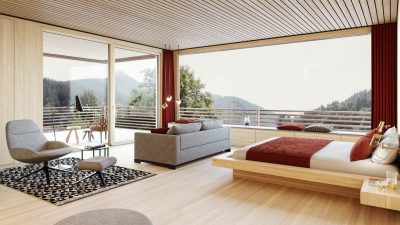Project Information
DI Thomas Fußenegger
Tobias Laukenmann M.A.
Florian Schwender M.A.
Andreas Ströhle M.Sc.
Arch. DI Roland Wehinger
Felix Dingeldein
Theresa Hammerl
Client
FMTG Development GmbH, Wien
Location
Latschau, Montafon
Competition
2019
Rights
Text Tina Mott
Image Thomas Knapp
- Structural Analysis
merz kley partner ZT GmbH, Dornbirn - Landscape Planning
Keller Damm Kollegen GmbH, München - Fire Protection Planning
K&M Brandschutztechnik GmbH, Lochau
Falkensteiner-Hotel, Latschau
The small scattered settlement of Latschau lies in the middle of a popular skiing and hiking area on a hill above the centre of Tschagguns. It is characterised by the middle station of the Golmer cable car and the elongated powerhouse of the Lünerseewerk and its reservoirs.
An exclusive family hotel with 130 rooms and suites is to be built here, integrating itself into the landscape in an independent yet site-specific architectural language. Fundamental to the design are the different qualities of the spatially differentiated building site. While the main area of the site is optimally connected to the surrounding infrastructure, the narrow southern annex has the effect, due to its extraordinary location, to be embedded in a characteristic Montafon Maisäss landscape.
The hotel’s sleeping wing is set as a self-confident four-storey volume to the north and connected to the spa and children’s area by a filigree bridge construction, which is integrated into the preserved cultural landscape as an independent structure. The power plant buildings are hidden from the perception of the hotel guests in order to bring the impressive mountain panorama to the fore.
A slightly curved ground plan allows for wide views over the alpine pastures and the valley as well as welcoming optimal sunlight. In addition, the building ensemble blends into the slope following the course of the terrain. Deep loggias divide the main volume and create private outdoor spaces. The ground floor is designed as a coherent zone with differentiated lounging areas and a strong connection to the landscape; in the southwest, a continuous covered terrace is created.
The particularly resource-saving timber-concrete hybrid construction method takes into account the ecological challenges of the sensitive site. Due to the high proportion of prefabricated construction elements, a particularly precise execution quality is achieved and the construction time is reduced.



